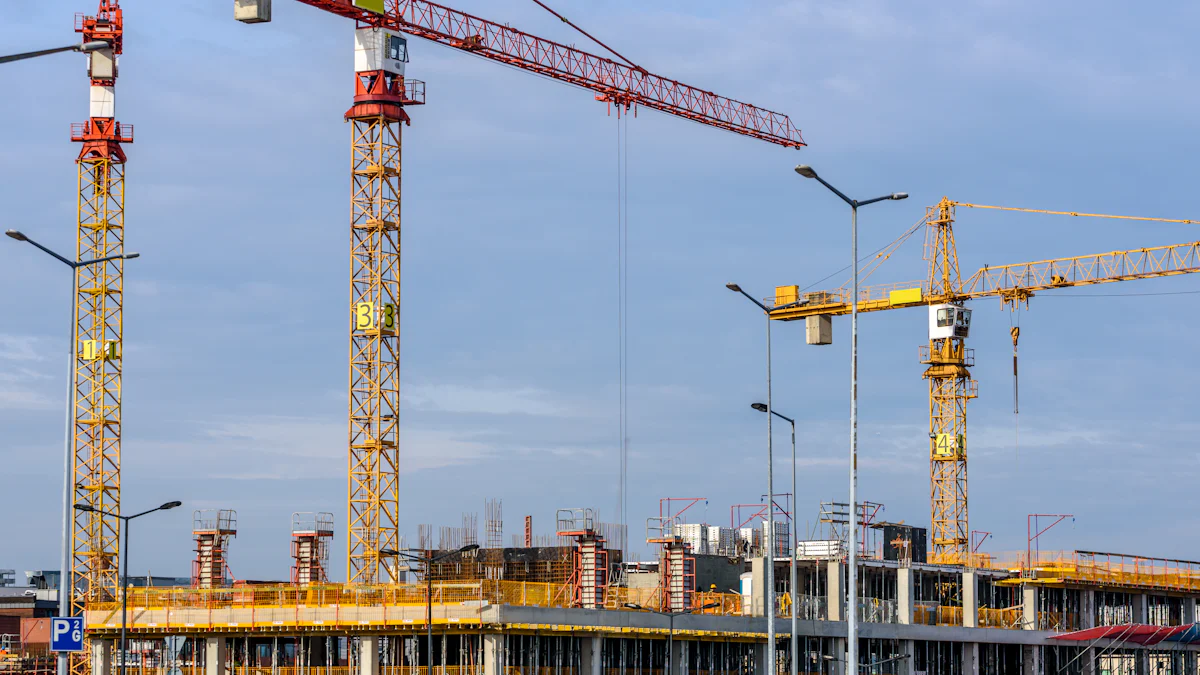Avoiding Hazards: Expert Advice for Overhead Crane Safety
Date: 2024-05-21 Share:
Avoiding Hazards: Expert Advice for Overhead Crane Safety
Understanding Overhead Cranes
Overhead cranes are essential pieces of equipment used in various industries for material handling and lifting tasks. There are several basic components that facilitate the movement of heavy loads with precision and efficiency.
The Basic Components of an Overhead Crane
When examining an overhead crane, it becomes evident that it comprises three fundamental parts:
The Bridge
The bridge, also known as the track, provides a secure path for the crane to traverse horizontally within a facility. It is designed to withstand substantial loads while ensuring smooth and controlled movement.
The Trolley
Mounted on the bridge, the trolley serves as the vehicle that travels back and forth, allowing for lateral movement of the load. This component plays a crucial role in positioning the load accurately during material handling operations.
The Hoist
The hoist is responsible for lifting and lowering the load vertically. It is equipped with robust mechanisms to ensure secure attachment and controlled movement of heavy objects, contributing to overall operational safety.
The Importance of Overhead Cranes in Material Handling
In light of statistical data from OSHA revealing that 90% of crane accidents are caused by human error, it becomes increasingly evident that investing in advanced overhead crane solutions can significantly mitigate risks associated with material handling operations. Furthermore, integrating condition monitoring systems can provide real-time insights into equipment functioning, enabling timely predictive maintenance and enhancing overall operational safety.
How does an overhead crane operate?
Overhead cranes are intricate pieces of machinery that require skilled operators to ensure safe and efficient operation. Understanding the operational aspects of an overhead crane is crucial for maintaining a secure working environment and preventing potential hazards.
The Role of the Operator
The operator of an overhead crane holds a pivotal responsibility in overseeing its safe and effective operation. Whether using manual controls or wired pendant stations, the operator’s proficiency directly impacts the precision and safety of load handling. According to BOSS Crane, “Cranes themselves, and the loads they carry, can have disastrous consequences when improperly handled.” This underscores the critical role of well-trained operators in minimizing risks associated with overhead crane operations.
Manual Controls: Operators utilize manual controls to maneuver the crane’s movements, including lifting, lowering, and horizontal travel. These controls demand attentiveness and dexterity to ensure accurate load positioning and smooth operational transitions.
Wired Pendant Stations: Wired pendant stations provide operators with a convenient interface for controlling various crane functions. Through this technology, operators can execute precise commands for load manipulation while maintaining a safe distance from the actual lifting process.
The Process of Moving Loads Horizontally
Moving loads horizontally with an overhead crane necessitates meticulous attention to detail and adherence to safety protocols to prevent accidents or damage to materials being transported.
Attaching the Load Properly
Prior to initiating any lifting operation, it is imperative to ensure that the load is securely attached to the hoist. T&M Cranes emphasizes that “proper attachment of loads is fundamental for safe overhead crane operations.” This involves inspecting slings, hooks, and other hardware components for integrity and suitability based on load specifications. By adhering to these guidelines, operators can mitigate risks associated with load detachment during transit.
The Importance of Warning Devices
Implementing warning devices such as bells or sirens before commencing hoisting maneuvers serves as a crucial safety measure during overhead crane operations. These audible signals alert personnel in the vicinity about impending load movement, reducing the likelihood of accidental collisions or obstructions. Moreover, hoisting slowly while ensuring that nothing links or catches on the load during raising or traveling is essential for preventing accidents and preserving material integrity.
Key Safety Precautions for Overhead Crane Operation
Ensuring the safe and efficient operation of overhead cranes involves adhering to key safety precautions that mitigate potential hazards and enhance workplace safety. By prioritizing proper equipment usage and implementing safe lifting practices, operators can significantly reduce the risk of accidents and material damage.
Ensuring Proper Use of Slings, Hooks, and Hardware
Selecting the Right Equipment
Selecting the appropriate slings, hooks, and hardware is paramount to ensuring the safe handling of loads during overhead crane operations. Choosing equipment that aligns with the specific load requirements and environmental conditions is essential for minimizing the risk of load instability or detachment. Operators should meticulously assess factors such as load weight, dimensions, and material composition to determine the most suitable equipment for each lifting task.
Regular Maintenance and Inspection
Regular maintenance and inspection routines are crucial for upholding the integrity and functionality of slings, hooks, and hardware components. Conducting routine inspections enables operators to detect signs of wear, corrosion, or structural weaknesses that could compromise equipment performance. By adhering to a structured maintenance schedule, potential issues can be identified early on, allowing for timely repairs or replacements to maintain optimal safety standards.
Safe Lifting Practices
Hoisting Slowly and Carefully
When initiating lifting maneuvers with an overhead crane, it is imperative to execute hoisting actions slowly and methodically. Rapid or abrupt hoisting can lead to load swinging or destabilization, posing risks to both personnel and materials in the vicinity. By prioritizing slow hoisting speeds, operators can maintain control over load movement while minimizing the potential for sudden shifts or collisions.
Avoiding Obstructions During Load Movement
During load movement operations, operators must remain vigilant in identifying and avoiding potential obstructions within the crane’s operational path. Vigilance plays a critical role in preventing accidental collisions with structural elements or other objects within the facility. Clear communication among personnel regarding designated pathways for load transportation further enhances operational safety by reducing the likelihood of obstructions impeding smooth load movement.
Implementing these safety precautions fosters a secure operational environment while promoting efficient material handling practices with overhead cranes.
Expert Advice on Avoiding Common Hazards
Learning from Past Incidents
In the realm of overhead crane safety, learning from past incidents is instrumental in identifying common hazards and implementing effective preventive measures. Case studies and analyses of historical crane accidents provide valuable insights into the root causes of mishaps and serve as a foundation for refining safety protocols.
One notable case study, titled “Overhead Crane Case Studies,” delves into the analysis of past incidents to identify recurring hazards and assess the effectiveness of safety protocols. The study underscores the significance of leveraging real-world scenarios to comprehend the complexities of overhead crane operations and prioritize safety measures accordingly. By examining specific instances where safety protocols were compromised, organizations can gain a comprehensive understanding of potential risks and proactively address them through targeted interventions.
Moreover, statistics from “Crane Accident Statistics” reveal that 90% of crane accidents stem from human error, with 80% attributed to operators exceeding operational capacity. This data emphasizes the critical need for continuous training and adherence to operational limits to mitigate human-related risks in overhead crane operations. By integrating these statistical insights into safety training programs, organizations can instill a heightened awareness of operational boundaries among crane operators, fostering a culture of vigilance and responsibility.
Implementing Safety Protocols
Training and Certification for Operators
An essential aspect of mitigating common hazards associated with overhead cranes lies in providing comprehensive training and certification programs for operators. The panel discussion on “Overhead Lifting Safety Innovations” highlights several new technologies designed to enhance operator proficiency and address safety challenges in overhead lifting operations. These innovations encompass advanced control systems, proximity sensors, and upper limit switches that contribute to heightened situational awareness and precision in load handling.
By incorporating these cutting-edge technologies into operator training curricula, organizations can equip their personnel with the necessary skills to navigate complex operational scenarios while adhering to stringent safety standards. Furthermore, emphasizing the importance of certification programs ensures that operators are well-versed in industry best practices, regulatory compliance, and emergency response protocols. This holistic approach fosters a culture of continuous learning and proficiency development among crane operators, bolstering overall operational safety.
Creating a Culture of Safety
Creating a culture of safety within an organization is pivotal for sustaining long-term hazard mitigation efforts in overhead crane operations. The article on “Latest Overhead Handling Technologies Enhance Safety and Productivity” sheds light on how innovative devices such as upper limit switches prevent lifting loads exceeding rated capacities—a crucial element in promoting safe material handling practices.
Organizations can leverage these technological advancements as catalysts for cultivating a pervasive commitment to safety across all levels of their workforce. Encouraging open communication channels for reporting potential hazards or near-miss incidents empowers employees to actively contribute to risk identification and mitigation strategies. Additionally, integrating regular safety audits and performance evaluations reinforces accountability while nurturing a collective ethos centered on proactive hazard prevention.
By embracing these expert recommendations on avoiding common hazards associated with overhead cranes, organizations can fortify their commitment to operational excellence while safeguarding personnel welfare.
Final Thoughts on Overhead Crane Safety
The Continuous Effort for Safety
Ensuring the safety of overhead crane operations is an ongoing endeavor that demands unwavering commitment and vigilance. Staying abreast of industry standards and regulatory requirements is paramount in upholding a culture of safety within workplaces.
Occupational Safety and Health Administration (OSHA) Regulations: The regulations set forth by OSHA underscore the imperative need for only trained, certified, and properly evaluated individuals to operate cranes on job sites. This legal emphasis serves as a cornerstone for reinforcing the significance of stringent safety practices in overhead crane operations.
Adhering to these regulations not only fosters compliance with legal mandates but also underscores the ethical responsibility of organizations to prioritize the well-being of their personnel. By integrating OSHA’s guidelines into operational protocols, companies can demonstrate their unwavering dedication to maintaining safe working environments while mitigating potential hazards associated with overhead crane usage.
Encouraging a Proactive Approach to Safety
Embracing a proactive approach to safety involves cultivating a collective ethos where every individual within an organization plays an active role in hazard identification and risk mitigation.
Safe Operation of Cranes: Emphasizing the importance of only certified, qualified, and trained individuals operating cranes, this document underscores the legal aspect of safety practices. By instilling a sense of shared responsibility among employees, organizations can harness the collective expertise and insights of their workforce to identify potential hazards and implement preventive measures effectively.
Fostering open channels for communication empowers employees at all levels to contribute valuable perspectives on safety protocols and operational best practices. Encouraging active participation in safety audits, incident reporting, and continuous improvement initiatives cultivates a harmonized environment where safety is not just a priority but an ingrained value upheld by everyone involved.
By embracing these principles, organizations can fortify their commitment to ensuring overhead crane safety while nurturing a workplace culture centered on proactive hazard prevention and continuous improvement.
Nante Crane
Nante Crane is a leading manufacturer of overhead cranes, known for their commitment to safety, quality, and efficiency. Their overhead cranes are designed with a keen focus on minimizing hazards and ensuring a safe working environment.
The primary structure of Nante Crane’s overhead cranes is the bridge, a horizontal beam that carries the load. It is typically composed of two end trucks and one or two bridge girders, depending on the crane’s capacity. The bridge girders are designed to withstand the load and the stress caused by the crane’s movement, thereby reducing the risk of structural failure.
The hoist and trolley, which lift and move the load along the bridge, are another critical part of the crane’s structure. Nante Crane offers a variety of hoists and trolleys, each designed for specific applications and load capacities. The hoist is equipped with a wire rope or chain, and a hook for attaching the load. The trolley is designed to move smoothly along the bridge, carrying the hoist and the load, thereby minimizing the risk of load drop.
Nante Crane’s overhead cranes also feature advanced drive mechanisms, which move the crane and trolley. These drive mechanisms are designed for smooth and precise movement, reducing the risk of sudden movements that could lead to accidents.
Furthermore, Nante Crane’s overhead cranes are equipped with a range of safety devices, such as limit switches and overload protectors, which prevent accidents and damage to the crane. These safety features are a testament to Nante Crane’s commitment to safety.
In conclusion, Nante Crane‘s overhead cranes are designed with a focus on safety, minimizing hazards and ensuring a safe working environment. Understanding the design and safety features of these cranes is crucial for anyone involved in their operation, maintenance, or inspection.




